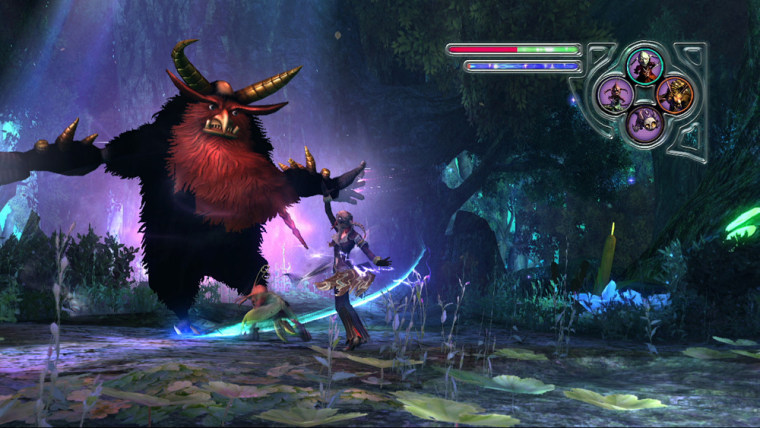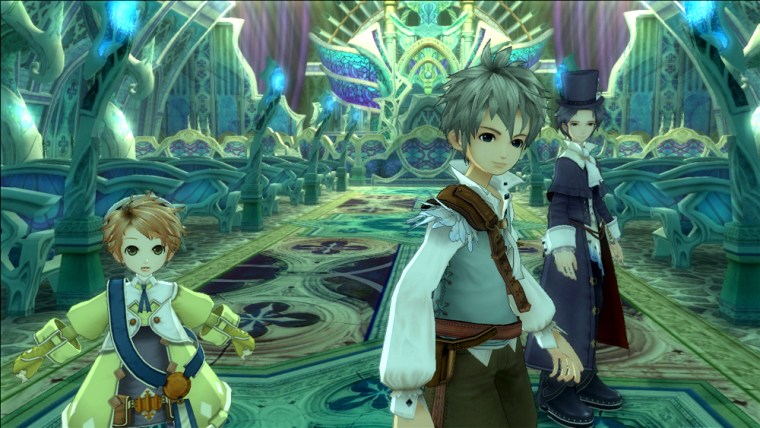For the record, I believe video games have the ability to be more than just a bit of good-time entertainment…that they can be more than mere digitized distractions. Call me crazy, but I believe video games have the ability to achieve that rare height we call "art."
Like the best films, there are games that weave the narrative, visual and sonic arts into innovative and inspiring masterpieces that will be admired for years to come. Like the great novels, there are games that speak to the human condition in their own distinct voices.
Granted, it's the infrequent video game that strives toward such high-falutin' stuff. (Most games just wanna be games, after all.) So imagine my happy surprise to find two new titles that seem to have genuine artistic aspirations tucked deep down in their entertaining little hearts.
"Eternal Sonata" for the Xbox 360 and "Folklore" for the PlayStation 3 are rare titles indeed. But before Matisse or Monet start doing back flips in their respective graves, I admit I'm not prepared to pronounce either game a masterpiece (they have too many flaws for that). Still, both games deserve praise (not to mention a place on your shelves) for their inspired efforts, creative achievements and, more importantly, for daring to aim high.
Both games boast stunning visuals, outstanding music and unique narratives. And both have shied away from some standard game trappings in favor of more imaginative pursuits. For those less interested in art and more interested in whether these games are actually fun, rest assured both titles offer innovative battle systems, plenty of thrilling action, and an intriguing blend of both the action/adventure and role-playing genres.
Yes, "Eternal Sonata" and "Folklore" prove that video games can be both arty and amusing at the same time.
Listen close to 'Eternal Sonata'
Alien invasions. World wars. Gangland violence. This is the meat and potatoes of video game storytelling. And so I say bravo to developer Tri-Crescendo for having the creative cajones to make a video game about the life and death of a sickly 19th-century composer.

"Eternal Sonata" stars Polish pianist Frederic Chopin who died of tuberculosis at age 39. In this lovely and visionary title, Chopin lays unconscious on his deathbed dreaming that he's visiting a fantastical world where he must join forces with a plucky-if-doomed girl named Polka and a cast of endearing characters as they go on a quest together to take down the evil Count Waltz.
But the question is: Is this world simply one of Chopin's fevered dreams, or is it reality? And who's to say which is which? This surprisingly sophisticated story also asks the player to consider heady topics such as the plight of the poor, the tyranny of the powerful and the damage done when mindless consumerism and modern "progress" steamroll the eternal rhythms of nature.
Seriously…all this from a video game.
Meanwhile, like a painting come to life, "Eternal Sonata's" visual design is breathtaking in its detail. Sun-dappled flower fields, lush forests and fantastical villages all sing with life.
And since Chopin is this game's muse, it's only appropriate that a musical theme runs throughout. Here, characters have names like Beat, Jazz and Allegretto and locations are given names like the Chorus Plains and Aria Temple. As "Eternal Sonata" progresses, the player unlocks playable Chopin compositions. And during the breaks between chapters, real-world photographs are used to illustrate history lessons from the composer's life – lessons that reflect on the unfolding dream-world story.
And then there's the game's unique combat system. Here, the traditional RPG turn-based battle style has been infused with real-time combat elements. You take three characters into battle at a time (Chopin wielding a conductor's baton among them). When it's a character's turn to do battle, you'll be given the freedom to run him or her around the battlefield for a certain amount of time, using various attacks against the baddies you're up against.
Meanwhile, each character's special attacks change depending on where that character is standing – in sunlight or in shadows. And when it's the enemy's turn to fight, you don't have to just stand there and take their abuse — you can block and counter-attack by pressing the B button at the right time. All in all, this makes for some truly exciting and strategically-challenging fights.
That's not to say that "Eternal Sonata" isn't without its problems. The game plays out in an extremely linear manner and while this gorgeous, musical world makes us yearn to run free and explore, alas, it's not to be. We're kept on an all-too-short leash.
Meanwhile, the story — delivered in long and sometimes rambling cutscenes — verges on being a bit too leisurely and preachy at times. The characters tend to share slow, meaningful looks as they have slow, meaningful conversations. And while I appreciate that the developers gave "Eternal Sonata" a pacing befitting its poetic heart, there are times I wish things would move at an allegro tempo.
Still, these negatives should not stop anyone from checking out what is a truly captivating and inspired game that deserves enormous praise for exploring fresh storytelling and gaming territory.
Meet the folk of 'Folklore'
While "Eternal Sonata" seems tapped into the more musical and poetic arts, "Folklore" seems inspired by the graphic arts — more specifically, the graphic novel. This eerie and fantastical new adventure/RPG for the PS3 feels very much like a dark comic book or perhaps a sinister fairy tale come to life.
As "Folklore" opens, two characters — a young woman searching for her mother and a reporter searching for a story — cross paths in the remote village of Doolin, a place where this world and the next also happen to cross paths.
Here the player alternately assumes the role of Ellen (the girl) and Keats (the reporter) as they try to unravel a murder mystery that haunts this gloomy burg. To do so, they must traverse two planes: the real world by day and the netherworld by night.
It's an intriguing tale delivered in a really intriguing way. That is, as you play through the game, the narrative is doled out to you in several different ways — through the usual cut scenes, through in-game conversation bubbles and, most uniquely, through segments done up like highly stylized comic book pages. This multifaceted method of storytelling can feel a bit disjointed at times but, for the most part, adds a distinctive and appropriately surreal flavor to the whole affair.

While the majority of the game storytelling and mystery solving is done when Keats and Ellen wander the real world, the majority of the action takes place when our characters venture through the seven realms of the netherworld. Here, our heroes must "collect" the spirits of various monsters and sprites — known as "folk" — that inhabit these realms. To collect a spirit, you must best its owner in battle.
I haven't been a big fan of the PS3's motion-sensitive SIXAXIS controller. But in "Folklore," it gets put to good use. When battling various folk, for example, you'll literally yank their spirits from their bodies by yanking the controller backwards. Though it sounds easy enough, there are times when you'll really have to work to pry a spirit free. All in all, it's a game element that feels good and adds a truly heart-pumping aspect to the game play.
Once you collect a specific folk's spirit you can then use that folk to defeat other folk. And the creature design here is absolutely wonderful. The netherworld is alive with more than 100 outlandish and fantastical monsters – the spiky Bargest, the fluttering Andraste, the fairy-like Pouke. (If "Folklore" is ever adapted into a film, Tim Burton should do the directing.) And once you've conscripted these creatures into your service, you'll not only be able to grow their power as weapons, but you must figure out which folk are best used to defeat other enemies.
Collecting these sprites and puzzling through when to use each one is a real pleasure as is exploring the worlds presented throughout "Folklore." Whether you're in Doolin or in one of the death realms, the visuals are magnificent. These are lush, moody environments that are only enhanced by the music and sound design details that are so thoughtfully sprinkled throughout.
It's only because I love exploring this world so much that I am most disappointed by how linear and limited the levels ultimately feel. As with "Eternal Sonata," "Folklore" presents me with the kind of tempting scenery I want to run off and explore — only to find myself confined to some narrow spaces. And since you alternately play this game from both Keats' and Ellen's perspectives, you quickly find yourself retracing very familiar ground.
Still, "Folklore" — like "Eternal Sonata" — absolutely should not be missed. These two titles point toward both the artistic and entertainment heights that gaming has to offer us.
